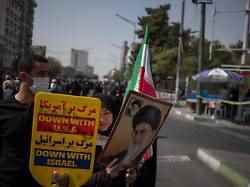Protests after Friday prayers
Iran’s regime is mobilizing its own supporters
09/24/2022 02:24 am
Anger at the moral police and the mullahs’ regime has been driving thousands of Iranians onto the streets for days. The government is not only using violence against the demonstrators, but also counter-protesting. After Friday prayers, government supporters march through the cities demanding “death to the conspirators”.
Iran’s armed forces have given the strongest warning of a disruption to security in the country given the ongoing protests. “We will not allow the enemies to take advantage of the situation,” quoted the Iranian news agency Isna from a statement. According to the Tasnim agency, the secret service also warned against participating in “illegal gatherings”.
Justice chief Gholam-Hussein Mohseni-Edschehi ordered the security forces to crack down on the nationwide protests on Thursday. At least 17 people have been killed in the riots, state television reports. However, activists fear a significantly higher number of victims through violence by the police and the Revolutionary Guards, which are considered particularly brutal. The Iran Human Rights (IHR) organization based in Oslo speaks of 36 confirmed deaths. When en masse opponents of the mullah regime took to the streets in November 2019, hundreds of people died in the bloody crackdown on the protests. Amnesty International speaks of at least 304 dead. At the time, the government shut down the internet for six days to make organizing the demonstrations more difficult and to prevent information from leaking out.
The current protests were triggered by the death of 22-year-old Iranian Mahsa Amini. She was arrested by the Morality Police just over a week ago for violating the strict Islamic dress code. What exactly happened to Amini after her arrest is unclear. Anyway, she went into a coma and died in a hospital on Friday. Critics accuse the morality police of using violence. The police deny the allegations. Since then, thousands of people have been demonstrating across the country against the government’s repressive course.
In response, the Iranian leadership mobilized its supporters. According to the state media, thousands of people took to the streets after Friday prayers to show solidarity with the government’s course. The government-organized demonstrations saw supporters marching through several cities, as shown on state television footage. According to the state news agency IRNA, the demonstrators also shouted slogans such as “Death America”, “Death Israel” or “Death to the conspirators” and “Our people are awake and hate troublemakers”. The state television pictures mostly showed men, but also a few women veiled in black.
Scholz expresses himself for the first time
Chancellor Olaf Scholz commented on the protests in Iran on Friday: “It is terrible that Mahsa Amini died in police custody in Tehran,” Scholz wrote on Twitter. “No matter where in the world: women must be able to live independently – without having to fear for their lives.”
In response to the protests, the government once again massively restricted access to the Internet, and mobile networks in particular have largely been shut down. Dozens of people have been arrested as part of the protests, according to Iranian media. Among them are not only participants in the riots, but also activists and journalists. The journalist Nilufar Hamedi, who was one of the first to publicize the Aminis case, was also arrested in the Iranian capital, Tehran.
Iran has had strict dress codes since the Islamic Revolution in 1979. In the big cities in particular, many women now see the rules as rather relaxed and, for example, only wear their headscarves on the back of their heads – to the annoyance of ultra-conservative politicians. Religious hardliners in parliament have been trying for months to have Islamic laws applied more strictly.
